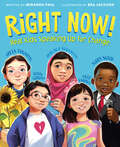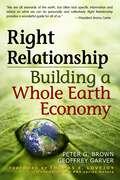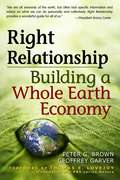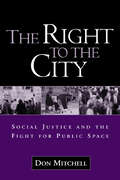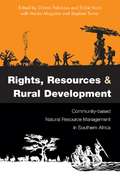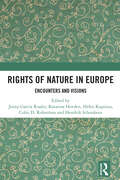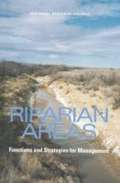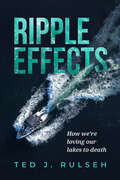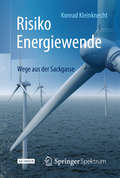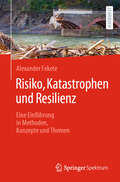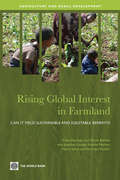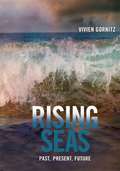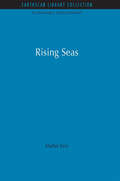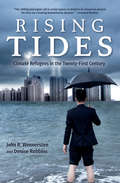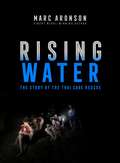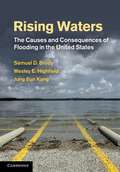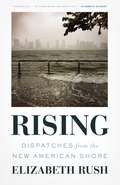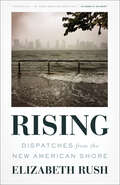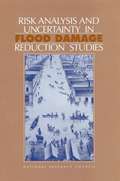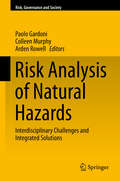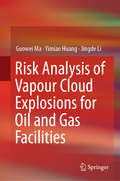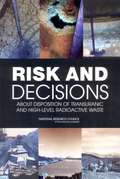- Table View
- List View
Rifts and Passive Margins
by Michal NemčokRifts and passive margins are extremely important for the petroleum industry, as they are areas of high sedimentation and can contain significant oil and gas resources. This book provides a comprehensive understanding of rifts and passive margins as a whole. It synthesises in one volume the existing information devoted to specific aspects of these vitally important hydrocarbon habitats. This collecting together of state-of-the-art information on the topic facilitates the better use of this knowledge to assess the risks of exploring and operating in these settings and the development of systematic and predictive hydrocarbon screening tools. The book will be invaluable for a broad range of readers, from advanced geology students and researchers to exploration geoscientists to exploration managers exploring for and developing hydrocarbon resources in analogous settings.
Right Now!: Real Kids Speaking Up for Change
by Miranda PaulA joyful, inspiring picture book that introduces readers to eleven young people from around the world who didn&’t wait until they were grown to speak up about things that matter to them and change the world for the better, from an award-winning author and New York Times best-selling illustrator.From climate activist Greta Thunberg to anti-bullying advocate Jaylen Arnold to peace activist Bana Alabed and more, these short profiles of young people and their causes will inspire readers to think about what matters most to them. An author's note, Actions to Make a Difference, and additional resources are also included, providing a roadmap for any kid who wants to make change and help others too.
Right Relationship: Building a Whole Earth Economy
by Peter G. Brown Geoff GarverOur current economic system—which assumes endless growth and limitless potential wealth—flies in the face of the fact that the earth’s resources are finite. The result is increasing destruction of the natural world and growing, sometimes lethal, tension between rich and poor, global north and south. Trying to fix problems piecemeal is not the solution. We need a comprehensive new vision of an economy that can serve people and all of life’s commonwealth. Peter G. Brown and Geoffrey Garver use the core Quaker principle of “right relationship”—interacting in a way that is respectful to all and that aids the common good—as the foundation for a new economic model. Right Relationship poses five basic questions: What is an economy for? How does it work? How big is too big? What’s fair? And how can it best be governed? Brown and Garver expose the antiquated, shortsighted, and downright dangerous assumptions that underlie our current answers to these questions, as well as the shortcomings of many current reform efforts. They propose new answers that combine an acute awareness of ecological limits with a fundamental focus on fairness and a concern with the spiritual, as well as material, well-being of the human race. Brown and Garver describe new forms of global governance that will be needed to get and keep the economy in right relationship. Individual citizens can and must play a part in bringing this relationship with life and the world into being. Ultimately the economy, as indeed life itself, is a series of interconnected relationships. An economy based on the idea of “right relationship” offers not only the promise of a bountiful future but also an opportunity to touch the fullness of human meaning and, some would say, the presence of the Divine.
Right Relationship: Building a Whole Earth Economy
by Peter G. Brown Geoffrey GarverOur current economic system is unsustainable. Its fundamental elements, unlimited growth, and endless wealth accumulation fly in the face of the fact that the Earth's resources are clearly finite.
Right to the City: Social Justice and the Fight for Public Space
by Don MitchellIn the wake of recent terrorist attacks, efforts to secure the American city have life-or-death implications. Yet demands for heightened surveillance and security throw into sharp relief timeless questions about the nature of public space, how it is to be used, and under what conditions. Blending historical and geographical analysis, this book examines the vital relationship between struggles over public space and movements for social justice in the United States. Presented are a series of linked cases that explore the judicial response to public demonstrations by early twentieth-century workers, and comparable legal issues surrounding anti-abortion protests today; the Free Speech Movement and the history of People's Park in Berkeley; and the plight of homeless people facing new laws against their presence in urban streets. The central focus is how political dissent gains meaning and momentum--and is regulated and policed--in the real, physical spaces of the city.
Rights Resources and Rural Development: Community-based Natural Resource Management in Southern Africa
by Stephen Turner Christo Fabricius Eddie Koch Hector MagomeCommunity-based natural resource management (CBNRM) is an approach that offers multiple related benefits: securing rural livelihoods; ensuring careful conservation and management of biodiversity and other resources; and empowering communities to manage these resources sustainably. Recently, however, the CBNRM concept has attracted criticism for failing in its promise of delivering significant local improvements and conserving biodiversity in some contexts. This book identifies the flaws in its application, which often have been swept under the carpet by those involved in the initiatives. The authors analyse them, and propose remedies for specific circumstances based on the lessons learned from CBNRM experience in southern Africa over more than a decade. The result is essential reading for all researchers, observers and practitioners who have focused on CBNRM in sustainable development programmes as a means to overcome poverty and conserve ecosystems in various parts of the globe. It is a vital tool in improving their methods and performance. In addition, academics, students and policy-makers in natural resource management, resource economics, resource governance and rural development will find it a very valuable and instructive resource.
Rights of Nature in Europe: Encounters and Visions
by Helen Kopnina Hendrik Schoukens Jenny García Ruales Katarina Hovden Colin D. RobertsonThis book addresses the recognition of the Rights of Nature (RoN) in Europe, examining their conceptualisation and implementation. RoN refers to a diverse set of legal developments that seek to redefine Nature's status within the law, gradually emerging as a novel template for environmental protection. Countries like Ecuador and New Zealand, each with distinct histories and ways of dwelling in the world, have pioneered a new era in environmental governance by legally acknowledging rights or personhood for nature, ecosystems, and more-than-human populations.In recent years, Europe has witnessed growing interest in RoN, with academic, legislative, and political initiatives gaining momentum. A significant development is the September 2022 passage of a law in the Spanish Parliament, granting legal personhood and rights to the Mar Menor, a saltwater lagoon severely affected by environmental degradation.Given the diversity in interpretations and articulations of ‘Rights of Nature’, this edited volume argues that their arrival in Europe fosters different kinds of interactions across distinct areas of law, knowledge, practices, and societal domains. The book employs a multidisciplinary approach, exploring these interactions in law and policy, anthropology, Indigenous worldviews and jurisprudence, philosophy, spiritual traditions, critical theory, animal communication, psychology, and social work.This book is tailored for scholars in law, political science, environmental studies, anthropology and cultural studies; as well as legal practitioners, NGOs, activists and policy-makers interested in ecology and environmental protection.
Ring of Fire
The Ring of Fire is a place where volcanoes ooze lava or blow their tops in powerful explosions. it's a place where earthquakes topple buildings or create monster waves. Where is this place? What causes these earthshaking events? You'll find out in this book!
Riparian Areas: Functions and Strategies for Management
by Committee on Riparian Zone Functioning Strategies For ManagementThe Clean Water Act (CWA) requires that wetlands be protected from degradation because of their important ecological functions including maintenance of high water quality and provision of fish and wildlife habitat. However, this protection generally does not encompass riparian areas--the lands bordering rivers and lakes--even though they often provide the same functions as wetlands. Growing recognition of the similarities in wetland and riparian area functioning and the differences in their legal protection led the NRC in 1999 to undertake a study of riparian "areas, which has culminated in Riparian Areas: Functions and Strategies for Management. The report is intended to heighten awareness of riparian areas commensurate with their ecological and societal values. The primary conclusion is that, because riparian areas perform a disproportionate number of biological and physical functions on a unit area basis, restoration of riparian functions along America's waterbodies should be a national goal.
Ripple Effects: How We're Loving Our Lakes to Death
by Ted J. RulsehLakes are among the Upper Midwest’s greatest treasures and most valuable natural resources. The Great Lakes define the region, and thousands of smaller lakes offer peace, joy, and recreation to millions. And yet, in large part because of the numbers of people who enjoy the local waterways, the lakes of Wisconsin, Michigan, and Minnesota face numerous challenges. Invasive species, pollution, defective septic systems, inadequate shoreland zoning laws, and climate change are present and increasingly existential threats. We are, quite possibly, loving our lakes to death. In his engaging and conversational style, Ted Rulseh details each of these challenges and proposes achievable solutions. He draws on personal experience, interviews, academic research, and government reports to describe the state of the lakes, the stresses they are under, and avenues to successful lakeside living for a sustainable future. Ripple Effects will be a go-to source for all who love lakes and who advocate for their protection; its driving question is summed up by one of Rulseh’s interviewees: “We love this lake. What can we do to keep it healthy?”
Risiko Energiewende
by Konrad KleinknechtDer Ausstieg aus der Nutzung der Kernenergie in Deutschland wurde im Sommer 2011 im Eiltempo beschlossen. Jetzt zeigt sich, dass es keinen realistischen Plan für den Umbau der Energieversorgung in der vorgesehenen Frist von zehn Jahren gibt. Für die Umstellung unserer gesamten Stromversorgung und damit unserer Wirtschaft ist der Zeitraum zu kurz. Es fehlt eine belastbare empirische Begründung, die Fragen der Versorgungssicherheit, der Finanzierbarkeit, der Auswirkungen auf die wirtschaftliche Entwicklung und die soziale Gerechtigkeit behandeln müsste. Somit droht diese Wende an ihren Widersprüchen zu scheitern. Konrad Kleinknecht versucht in seinem Buch, die Probleme zu benennen und Antworten zu finden. Für ihn stellen sich die folgenden Fragen: Welche Möglichkeit haben wir, mit Windkraft und Solarenergie einen Teil der Stromversorgung zu ersetzen? Welche Stromquellen bieten gesicherte Leistung? Können wir auf Kohlekraftwerke verzichten? Brauchen wir neue Stromtrassen? Wie lässt sich Strom speichern? Wie real ist die Gefahr eines Blackouts in windstillen Nächten? Werden die Strompreise weiter steigen? Lassen sich mit einer grundlegenden Reform des Erneuerbare-Energien-Gesetzes (EEG) die großen Risiken der Energiewende noch vermeiden? Die Energieversorgung muss dem Wohl des Ganzen dienen und dem Industriestandort Deutschland nutzen. Ein Blackout wäre eine Katastrophe für das ganze Land, er muss unter allen Umständen vermieden werden. Wie wir dies bewerkstelligen können, vermittelt der Autor in seinem aufrüttelndem Buch.
Risiko, Katastrophen und Resilienz: Eine Einführung in Methoden, Konzepte und Themen
by Alexander FeketeWöchentlich gibt es neue Meldungen über Krisen und Katastrophen weltweit. Einige der Risiken und inzwischen auch der Ereignisse überschlagen sich und man hat es in einigen Regionen zum Beispiel gleichzeitig mit einem Hochwasser, einer Pandemie und einer Bedrohung von Lieferketten durch einen fernen Krieg zu tun. Diese multiplen Krisen stellen die Gesellschaft vor große Herausforderungen. Während Einzelne aufgrund der Vielzahl dieser Vorfälle, deren Fremdheit und Komplexität zunehmend abschalten, bedarf es auf der anderen Seite Menschen, die sich sowohl in der Praxis als auch in der Forschung damit beschäftigen. Dass sich Vorsorge nicht nur beim Klimawandel, sondern auch bei Lieferkettenabhängigkeiten der Kritischen Infrastruktur oder Notfalleinsätzen lohnt, ist eigentlich offensichtlich. Es mangelt leider oft an der Umsetzung von Maßnahmen, gerade dann, je länger ein aufsehenerregendes Ereignis zurückliegt.Dieses Buch bietet allen Interessierten einen Einstiegin das Thema der Risiko-, Katastrophen- und Resilienzforschung. Es stellt eine schrittweise Anleitung für Risiko- und Verwundbarkeitsanalysen sowie Konzepte für Resilienz dar und illustriert anhand von Fallstudien, insbesondere im Bereich des Hochwasserrisikos. Darüber hinaus werden erstmals zahlreiche theoretische Rahmenwerke aus dem Englischen ins Deutsche übertragen und präsentiert. Dies eröffnet Ihnen einen breiteren Zugang zu internationalen Forschungsergebnissen. Ein besonderer Fokus liegt dabei auf kritischen Infrastrukturen im Bevölkerungsschutz und Geographischen Informationssystemen und deren Anwendung im Katastrophen-Management.Abgerundet wird das Buch durch Ausblicke auf noch zu entwickelnde spezielle Methoden, um die Risiko- und Resilienzforschung stärker mit großen gesellschaftlichen Themen wie Sicherheit, Nachhaltigkeit und Daseinsvorsorge zu verknüpfen. Warum begeistern sich Menschen aus Disziplinen wie den Geowissenschaften, dem Rettungsingenieurwesen, der Stadt- und Regionalplanung und vielen anderen für dieses Thema? Dieses Buch bietet Einblicke in ihre Motivation und zeigt, wie vielfältig und wichtig die Forschung auf diesem Gebiet ist.
Rising Global Interest in Farmland: Can It Yield Sustainable and Equitable Benefits?
by Andrew Norton Klaus Deininger Jonathan Lindsay Harris Selod Derek Byerlee Mercedes SticklerThis book aims to provide key pieces of information needed for informed debate about large-scale land acquisition by drawing on the experience from past land expansions, discussing predictions for potential future demand, and providing empirical evidence of what is happening on the ground in the countries most affected by the recent increase in demand for land. It complements demand side considerations with a detailed assessment of the amount of land, whether currently cultivated or not, that might potentially be available for agricultural cultivation at the global and country levels. It then describes in some detail the policies in place to manage land acquisition processes and analyzes how these policies may affect outcomes. This information can help governments in land abundant countries to assess how best to integrate increased demand for land into their rural development strategies and provide opportunities and benefits to all involved, including existing smallholders. This is particularly important as many of these countries also have high yield gaps. It also highlights how, in cases where land acquisition by large investors makes sense from a social, economic, and environmental perspective, governments can create an environment that can help to attract outside investment that contributes to broad-based growth and poverty reduction.
Rising Seas: Past, Present, Future
by Vivien GornitzThe Earth's climate is already warming due to increased concentrations of human-produced greenhouse gases in the atmosphere, and the specter of rising sea level is one of global warming's most far-reaching threats. Sea level will keep rising long after greenhouse gas emissions have ceased, because of the delay in penetration of surface warming to the ocean depths and because of the slow dissipation of excess atmospheric carbon dioxide. Adopting a long perspective that interprets sea level changes both underway and expected in the near future, Vivien Gornitz completes a highly relevant and necessary study of an unprecedented age in Earth's history. Gornitz consults past climate archives to help better anticipate future developments and prepare for them more effectively. She focuses on several understudied historical events, including the Paleocene-Eocene Thermal Anomaly, the Messinian salinity crisis, the rapid filling of the Black Sea (which may have inspired the story of Noah's flood), and the Storrega submarine slide, an incident possibly connected to a sea level occurrence roughly 8,000 years old. By examining dramatic variations in past sea level and climate, Gornitz concretizes the potential consequences of rapid, human-induced warming. She builds historical precedent for coastal hazards associated with a higher ocean level, such as increased damage from storm surge flooding, even if storm characteristics remain unchanged. Citing the examples of Rotterdam, London, New York City, and other forward-looking urban centers that are effectively preparing for higher sea level, Gornitz also delineates the difficult economic and political choices of curbing carbon emissions while underscoring, through past geological analysis, the urgent need to do so.
Rising Seas: Past, Present, Future
by Vivien GornitzThe Earth's climate is already warming due to increased concentrations of human-produced greenhouse gases in the atmosphere, and the specter of rising sea level is one of global warming's most far-reaching threats. Sea level will keep rising long after greenhouse gas emissions have ceased, because of the delay in penetration of surface warming to the ocean depths and because of the slow dissipation of excess atmospheric carbon dioxide. Adopting a long perspective that interprets sea level changes both underway and expected in the near future, Vivien Gornitz completes a highly relevant and necessary study of an unprecedented age in Earth's history.Gornitz consults past climate archives to help better anticipate future developments and prepare for them more effectively. She focuses on several understudied historical events, including the Paleocene-Eocene Thermal Anomaly, the Messinian salinity crisis, the rapid filling of the Black Sea (which may have inspired the story of Noah's flood), and the Storrega submarine slide, an incident possibly connected to a sea level occurrence roughly 8,000 years old. By examining dramatic variations in past sea level and climate, Gornitz concretizes the potential consequences of rapid, human-induced warming. She builds historical precedent for coastal hazards associated with a higher ocean level, such as increased damage from storm surge flooding, even if storm characteristics remain unchanged. Citing the examples of Rotterdam, London, New York City, and other forward-looking urban centers that are effectively preparing for higher sea level, Gornitz also delineates the difficult economic and political choices of curbing carbon emissions while underscoring, through past geological analysis, the urgent need to do so.
Rising Seas: Rising Seas (Sustainable Development Set)
by Martin InceRecent and dramatic flooding in places as far apart as Bangladesh and North Wales are example of what could become commonplace if sea levels rise. Most scientists are predicting a rise of about one metre and this book, based on research carried out for the Commonwealth governments, describes in simple terms what in. likely to happen as a result and where the worst effects will be. Martin Ince, a well-known scientific journalist, deals with the accuracy of our knowledge and the possible errors in assessment. He considers the different kinds of damage that higher seas could cause, inundation, increased salination, coral damage, increased flood and surge damage and so on. Brief case studies are included covering the UK, the Maldives, North America, Bangladesh, Guyana, Kiribati, The Netherlands, Italy, Egypt and Australasia. The book ends with an examination of the scientific and technical developments which could make the problems easier to deal with and, above all, set. out the policies on which governments must agree. Originally published in 1990
Rising Tides: Climate Refugees in the Twenty-First Century (Encounters: Explorations in Folklore and Ethnomusicology)
by John R. Wennersten and Denise Robbins&“Deals masterfully with a neglected crisis, how climate change is driving migration . . . The work broaches solutions both practical . . . and political.&”—Christopher E. Goldthwait, former US Ambassador With global climate change upon us, it is imperative to start thinking about the massive numbers of people who will be displaced by environmental crises. The rise in sea levels alone will account for hundreds of millions of refugees around the globe. In Rising Tides, John R. Wennersten and Denise Robbins face the difficult questions that will have to be answered: How will people be relocated and settled? Is it possible to offer environmental refugees temporary or permanent asylum? Will these refugees have any collective rights in the new areas they inhabit? And lastly, who will pay the costs of all the affected countries during the process of resettlement? Offering an essential, continent-by-continent look at these dangers, Rising Tides is &“a passionately argued, well-documented wake-up call on the dire, current and undeniable human fallout from climate change. Looking behind the headlines, it connects the dots in a way that will inform and should alarm us all&” (Eugene L. Meyer, author of Five for Freedom). &“This chilling and urgent call to action spares no detail in its mission to present the facts on a looming humanitarian disaster. Climate-change warning messages too often focus on the environment without going into specifics of how humans will be hurt by global warming. Rising Tides singlehandedly rectifies this issue.&”—Foreword Reviews &“A must read for policymakers and those in positions of power, especially the ones who remain in a state of denial about climate change and refuse to do enough to address the crisis.&”—The Hindu
Rising Water: The Story of the Thai Cave Rescue
by Marc AronsonThe incredible true story of the twelve boys trapped with their coach in a flooded cave in Thailand and their inspiring rescue—as seen in Ron Howard's Thirteen Lives.On June 23, 2018, twelve members of the Wild Boars soccer team and their coach were exploring the Tham Luang cave complex in northern Thailand when disaster struck. A rainy season downpour flooded the tunnels, trapping them as they took shelter on a shelf of the dark cave. Eight days of searching yielded no signs of life, but on July 2 they were discovered by two British divers. The boys and their coach were eventually rescued in an international operation that took three days. What could have been a terrible tragedy became an amazing story of survival. Award-winning author Marc Aronson brings us the backstory behind how this astounding rescue took place. Rising Water highlights the creative thinking and technology that made a successful mission possible by examining the physical, environmental, and psychological factors surrounding the rescue. From the brave Thai Navy SEAL who lost his life while placing oxygen tanks along the passageways of the cave, to the British divers that ultimately swam the boys to safety, to the bravery of the boys and their coach, this is the breathtaking rescue that captivated the entire world.
Rising Waters
by Samuel D. Brody Wesley E. Highfield Jung Eun KangIn the wake of Hurricane Katrina and the flooding of New Orleans in 2005, this interdisciplinary book brings together five years of empirical research funded by the National Science Foundation. It explores the causes of flooding in the United States and the ways in which local communities can reduce the associated human casualties and property damage. Focussing on Texas and Florida, the authors investigate factors other than rainfall that determine the degree of flooding, and consider the key role of non-structural techniques and strategies in flood mitigation. The authors present an empirical and multi-scale assessment that underlines the critical importance of local planning and development decisions. Written for advanced students and researchers in hazard mitigation, hydrology, geography, environmental planning and public policy, this book will also provide policy makers, government employees and engineers with important insights into how to make their communities more resilient to the adverse impacts of flooding.
Rising: Dispatches from the New American Shore
by Elizabeth RushHailed as “deeply felt” (New York Times), “a revelation” (Pacific Standard), and “the book on climate change and sea levels that was missing” (Chicago Tribune), Rising is both a highly original work of lyric reportage and a haunting meditation on how to let go of the places we love. <P><P>With every passing day, and every record-breaking hurricane, it grows clearer that climate change is neither imagined nor distant―and that rising seas are transforming the coastline of the United States in irrevocable ways. In Rising, Elizabeth Rush guides readers through some of the places where this change has been most dramatic, from the Gulf Coast to Miami, and from New York City to the Bay Area. For many of the plants, animals, and humans in these places, the options are stark: retreat or perish in place. <P><P>Weaving firsthand testimonials from those facing this choice―a Staten Islander who lost her father during Sandy, the remaining holdouts of a Native American community on a drowning Isle de Jean Charles, a neighborhood in Pensacola settled by escaped slaves hundreds of years ago―with profiles of wildlife biologists, activists, and other members of these vulnerable communities, Rising privileges the voices of those too often kept at the margins.
Rising: Dispatches from the New American Shore
by Elizabeth RushA Pulitzer Prize Finalist, this powerful elegy for our disappearing coast “captures nature with precise words that almost amount to poetry” (The New York Times).Hailed as “the book on climate change and sea levels that was missing” (Chicago Tribune), Rising is both a highly original work of lyric reportage and a haunting meditation on how to let go of the places we love.With every record-breaking hurricane, it grows clearer that climate change is neither imagined nor distant—and that rising seas are transforming the coastline of the United States in irrevocable ways. In Rising, Elizabeth Rush guides readers through these dramatic changes, from the Gulf Coast to Miami, and from New York City to the Bay Area. For many of the plants, animals, and humans in these places, the options are stark: retreat or perish.Rush sheds light on the unfolding crises through firsthand testimonials—a Staten Islander who lost her father during Sandy, the remaining holdouts of a Native American community on a drowning Isle de Jean Charles, a neighborhood in Pensacola settled by escaped slaves hundreds of years ago—woven together with profiles of wildlife biologists, activists, and other members of these vulnerable communities.A Guardian, Publishers Weekly, and Library Journal Best Book Of 2018Winner of the National Outdoor Book AwardA Chicago Tribune Top Ten Book of 2018
Risk Analysis And Uncertainty In Flood Damage Reduction Studies
by Committee on Risk-Based Analysis for Flood Damage ReductionReducing flood damage is a complex task that requires multidisciplinary understanding of the earth sciences and civil engineering. In addressing this task the U.S. Army Corps of Engineers employs its expertise in hydrology, hydraulics, and geotechnical and structural engineering. Dams, levees, and other river-training works must be sized to local conditions; geotechnical theories and applications help ensure that structures will safely withstand potential hydraulic and seismic forces; and economic considerations must be balanced to ensure that reductions in flood damages are proportionate with project costs and associated impacts on social, economic, and environmental values.A new National Research Council report, Risk Analysis and Uncertainty in Flood Damage Reduction Studies, reviews the Corps of Engineers' risk-based techniques in its flood damage reduction studies and makes recommendations for improving these techniques. Areas in which the Corps has made good progress are noted, and several steps that could improve the Corps' risk-based techniques in engineering and economics applications for flood damage reduction are identified. The report also includes recommendations for improving the federal levee certification program, for broadening the scope of flood damage reduction planning, and for improving communication of risk-based concepts.
Risk Analysis of Natural Hazards
by Colleen Murphy Paolo Gardoni Arden RowellThis volume investigates the interdisciplinary and cross-cutting challenges in the risk analysis of natural hazards. It brings together leading minds in engineering, science, philosophy, law, and the social sciences. Parts I and II of this volume explore risk assessment, first by providing an overview of the interdisciplinary interactions involved in the assessment of natural hazards, and then by exploring the particular impacts of climate change on natural hazard assessment. Part III discusses the theoretical frameworks for the evaluation of natural hazards. Finally, Parts IV and V address the risk management of natural hazards, providing first an overview of the interdisciplinary interactions underlying natural hazard management, and then exploring decision frameworks that can help decision makers integrate and respond to the complex relationships among natural events, the built environment, and human behavior.
Risk Analysis of Vapour Cloud Explosions for Oil and Gas Facilities
by Guowei Ma Yimiao Huang Jingde LiThis book focuses on describing and applying risk analysis of vapour cloud explosions (VCEs) in various oil and gas facilities, such as petrol stations, processing plants, and offshore platforms. Discussing most of the complicated features of gas explosion accidents, the book studies in detail the gas explosion risk analysis approaches of different oil and gas facilities in order to develop more accurate, detailed, efficient and reliable risk analysis methods for VCEs under different conditions. Moreover, it introduces an advanced overpressure approach to predict VCEs using computational fluid dynamics (CFD) modelling, and details applications of CFD using a FLame ACceleration Simulator (FLACS). The book is intended for researchers and organisations engaged in risk and safety assessments of VCEs in the oil and gas industry.
Risk And Decisions: About Disposition Of Transuranic And High-level Radioactive Waste
by Committee on Risk-Based Approaches for Disposition of Transuranic High-Level Radioactive WasteThe U.S. Department of Energy (DOE) manages dozens of sites across the nation that focus on research, design, and production of nuclear weapons and nuclear reactors for defense applications. Radioactive wastes at these sites pose a national challenge, and DOE is considering how to most effectively clean them up. Some of the greatest projected risks, cleanup costs, and technical challenges come from processing and disposing transuranic and high-level radioactive waste. This report addresses how DOE should incorporate risk into decisions about whether the nation should use alternatives to deep geologic disposal for some of these wastes. It recommends using an exemption process involving risk assessment for determining how to dispose of problematic wastes. The report outlines criteria for risk assessment and key elements of a risk-informed approach. The report also describes the types of wastes that are candidates for alternative disposition paths, potential alternatives to deep geologic disposal for disposition of low-hazard waste, and whether these alternatives are compatible with current regulations.

